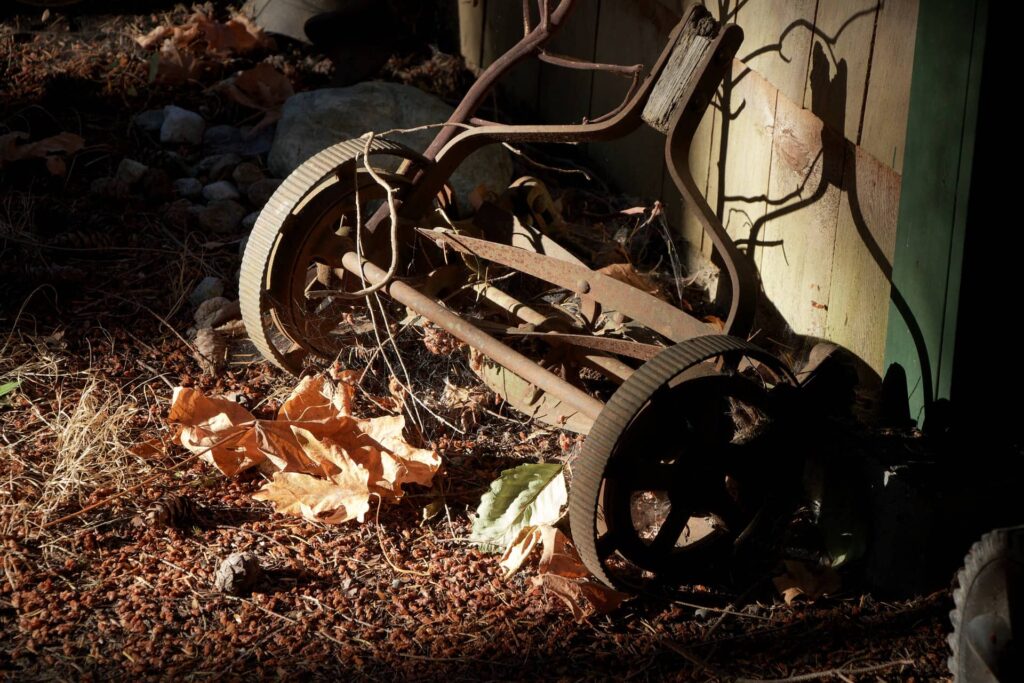Introduction: The Roots of Lawn Care
The history of lawn care is a tale as old as civilization itself, spanning millennia and continents. From the carefully tended grasslands of ancient societies to the meticulously manicured lawns of modern suburbs, the concept of a well-maintained lawn has been a constant in human landscaping. This journey through time reveals not just the evolution of lawn maintenance techniques, but also shifts in cultural values, technological advancements, and our relationship with nature.
| Era | Key Takeaways |
|---|---|
| Ancient Origins | • Early civilizations maintained grassy areas for practical and aesthetic purposes • Basic techniques included grazing animals and manual cutting |
| Medieval Period | • Lawns transitioned from functional to ornamental in European monasteries and castles • Introduction of manual shears and selective grass growing |
| Renaissance | • Lawns became status symbols in grand gardens • Development of more sophisticated maintenance techniques |
| 17th-18th Centuries | • Rise of the English lawn as the gold standard • Invention of the mechanical lawn mower |
| Industrial Revolution | • Mechanization of lawn care tools • Lawn maintenance became more accessible to the general public |
| 19th Century America | • Lawns became a standard feature in residential landscapes • Frederick Law Olmsted’s influence on American lawn design |
| Early 20th Century | • Emergence of turfgrass science • Development of specialized grass varieties and care techniques |
| Post-World War II | • Suburban lawn boom • Rise of the lawn care industry and chemical products |
| Late 20th Century | • Growing environmental concerns • Shift towards organic and low-impact lawn care methods |
| 21st Century | • Integration of smart technology in lawn care • Focus on sustainable practices and biodiversity |
| Future Trends | • Emphasis on drought-resistant species and lawn alternatives • Balancing tradition with environmental responsibility |
Understanding the lawn history provides us with valuable insights into how our ancestors viewed and interacted with their environment. It also helps us appreciate the complex interplay between aesthetics, function, and ecology that continues to shape our approach to lawn care today. As we delve into this verdant past, we’ll uncover the roots of practices we now take for granted and explore how the humble lawn became a cornerstone of landscape architecture.
Ancient Origins: The Birth of Ornamental Grasses
The concept of managed grasslands dates back to some of the earliest civilizations. While not quite the lawns we know today, these areas served both practical and aesthetic purposes. In ancient Mesopotamia, for instance, grassy courtyards were maintained around temples, providing a serene environment for worship and contemplation.
Early lawn care techniques were far from the sophisticated methods we use today:
- Grazing animals were often used to keep grass short
- Hand-held sickles and scythes were employed for manual cutting
- Grasslands were sometimes burned to promote new growth
These ancient grasslands weren’t just for show. They played crucial roles in early agriculture, serving as pastures for livestock and sources of grain for human consumption. The dual nature of grass as both functional and ornamental would continue to influence its cultivation throughout history.
Medieval Period: From Functional to Fashionable
As we move into the medieval period, we see a gradual shift in the perception of managed grassy areas. While still serving practical purposes, lawns began to take on a more aesthetic role, particularly in European monasteries and castles.
The medieval castle lawn was not just a pretty face – it served as a crucial open space for gatherings, and tournaments, and even as a defense mechanism, providing clear lines of sight for archers.
During this time, lawn maintenance techniques evolved:
- Manually operated shears came into use for more precise cutting
- Specialized grass species were selectively grown for hardiness and appearance
- The concept of regular mowing began to take shape
It was during this period that the foundations for modern lawn care were laid, setting the stage for the ornamental lawns that would become fashionable in later centuries. And from these foundations came some of the lawn care basics that we know and love today.
The Renaissance: Lawns as Status Symbols

The Renaissance period saw a flourishing of art, culture, and landscape design. Lawns transitioned from purely functional spaces to carefully crafted elements of grand gardens. The European invention of the formal lawn, as we know it today, can be traced to this era.
Renaissance lawn care practices included:
- More frequent mowing, often using animals to pull cutting devices
- The introduction of rolling to create smoother surfaces
- Experimentation with different grass species for visual effect
Notable examples of Renaissance-era lawns include:
| Garden | Location | Notable Features |
|---|---|---|
| Villa d’Este | Tivoli, Italy | Terraced lawns and water features |
| Château de Versailles | France | Vast, geometric lawns |
| Hampton Court Palace | England | Tudor-style knot gardens with lawns |
These grand displays of horticultural prowess served as status symbols for the wealthy and powerful, setting a trend that would influence lawn design for centuries to come.
17th-18th Centuries: The Rise of the English Lawn
The English lawn, perhaps the most influential style in lawn history, came to prominence during this period. Characterized by its lush, closely cropped appearance, the English lawn became the gold standard for lawn maintenance across Europe and later, North America.
Key figures in the development of the English lawn include:
- Lancelot “Capability” Brown: Pioneered the naturalistic landscape style
- Humphry Repton: Further refined the concept of the “picturesque” garden
The popularity of the English lawn was driven by several factors:
- It symbolized man’s control over nature
- It provided a perfect backdrop for showcasing architecture
- It served as an ideal surface for leisure activities like lawn bowling
The evolution of lawn mowing techniques during this time was significant:
- Scythes gave way to more efficient horse-drawn mowers
- The first patent for a mechanical lawn mower was granted to Edwin Budding in 1830
This period laid the groundwork for the lawn care industry as we know it today, setting standards for appearance and maintenance that still influence our practices.
Industrial Revolution: Mechanizing Lawn Care

The Industrial Revolution brought about sweeping changes in all aspects of life, including lawn care. The mechanization of lawnmowers and other tools made it possible for more people to maintain lawns, democratizing what had once been a luxury of the wealthy.
Key developments in lawn care technology during this period included:
- The mass production of lawnmowers, making them more affordable
- The invention of the reel mower, which provided a cleaner cut
- The development of early chemical fertilizers and pesticides
These advancements had a profound impact on lawn maintenance:
- Lawns could be cut more frequently, leading to denser, more uniform grass
- The time required for lawn care was significantly reduced
- The ideal of a perfectly manicured lawn became more achievable for the average homeowner
19th Century America: Lawns Go Mainstream
The concept of the lawn as a standard feature of residential landscapes took root in 19th-century America. The American lawn became a symbol of civic pride, community cohesion, and individual achievement.
Frederick Law Olmsted, often considered the father of American landscape architecture, played a crucial role in popularizing lawns. His designs for public parks and planned communities like Riverside, Illinois, featured expansive green spaces that set a new standard for American landscaping.
Differences between European and American lawn care practices emerged:
| European Lawns | American Lawns |
|---|---|
| Often formal and geometric | More naturalistic and flowing |
| Primarily ornamental | Blend of ornamental and functional |
| Limited to estates and public spaces | Widely adopted in residential areas |
The spread of lawn culture in America was facilitated by:
- The growth of suburbs and increased homeownership
- The establishment of the U.S. Department of Agriculture, which researched turfgrass
- The rise of lawn care as a hobby and a mark of good citizenship
Early 20th Century: The Science of Turf Management
The dawn of the 20th century saw the emergence of turfgrass science as a distinct field of study. This period marked a shift towards more scientific and systematic approaches to lawn care.
Key developments in turf management included:
- Breeding of new grass varieties for specific climates and uses
- Research into optimal mowing heights and frequencies
- Development of more effective fertilizers and pest control methods
The United States Golf Association (USGA) played a significant role in advancing turfgrass research, driven by the need for high-quality playing surfaces. This research eventually trickled down to benefit residential lawn care as well.
Post-World War II: The Suburban Lawn Boom
The post-war period saw an explosion in suburbanization across America, accompanied by a boom in lawn ownership and care. The perfect lawn became a cultural ideal, symbolizing the American dream of homeownership and prosperity.
Factors contributing to the suburban lawn boom:
- GI Bill and increased homeownership
- Mass production of lawn care tools and products
- Rise of chemical lawn products like “Weed & Feed”
Advertising and media played a crucial role in shaping lawn care expectations:
This era saw the rise of the lawn care industry as we know it today, with a proliferation of products and services aimed at helping homeowners achieve the perfect lawn.
Late 20th Century: Environmental Concerns and Organic Approaches
As awareness grew about the environmental impacts of traditional lawn care practices, there was a shift towards more sustainable and organic lawns. This period saw a reevaluation of the perfect lawn ideal and the emergence of alternative approaches.
Key environmental concerns included:
- Overuse of chemical pesticides and fertilizers
- Excessive water consumption for lawn maintenance
- Loss of biodiversity due to monoculture lawns
In response, organic and low-impact lawn care methods gained popularity:
- Use of natural fertilizers and pest control methods
- Adoption of native plant species that require less water and maintenance
- Acceptance of some weeds and imperfections in lawn appearance
Water conservation efforts also influenced lawn maintenance, with drought-tolerant landscaping becoming more common in arid regions.
21st Century: Smart Technology and Sustainable Practices

The current era of lawn care is characterized by a blend of high-tech solutions and a return to more natural, sustainable practices. Smart technology and a focus on ecology are shaping the future of lawn maintenance.
Modern lawn care innovations include:
- Robotic lawn mowers guided by AI and GPS
- Smart irrigation systems that adjust based on weather conditions
- Soil sensors that provide real-time data on nutrient levels
At the same time, there’s a growing emphasis on sustainable practices:
- Use of native plants and grass alternatives to create biodiverse lawns
- Adoption of permaculture principles in lawn design
- Integration of lawns into broader eco-friendly landscaping schemes
Case Study: The Lawn Reform Coalition
The Lawn Reform Coalition, founded in 2009, advocates for reducing or eliminating resource-intensive lawns in favor of more sustainable landscapes. Their work has influenced both homeowners and policymakers, leading to changes in lawn care regulations in several states.
The Future of Lawn Care: Balancing Tradition and Innovation
As we look to the future of lawn care, we see a landscape where tradition and innovation coexist. The challenges of climate change and resource conservation are driving new approaches to lawn maintenance, while the cultural significance of lawns ensures their continued presence in our communities.
Predictions for the future of lawn care:
- Increased use of drought-resistant grass species and lawn alternatives
- Further integration of AI and robotics in lawn maintenance tools
- Development of more effective organic lawn care products
- Greater emphasis on lawns as part of larger ecosystems rather than isolated spaces
The role of lawns in urban planning is also evolving, with more cities incorporating green spaces that serve multiple functions – from recreation to stormwater management.
Conclusion: Lessons from Lawn Care History
The history of lawn care is a testament to human ingenuity and our complex relationship with nature. From the practical grasslands of ancient civilizations to the smart lawns of today, our approach to maintaining grassy spaces has continually evolved.
Key takeaways from this journey through lawn care history:
- Lawns have served both practical and aesthetic purposes throughout history
- Technological advancements have dramatically changed how we maintain lawns
- Cultural values and environmental concerns shape our approach to lawn care
- The future of lawn care lies in balancing tradition with sustainability
As we move forward, the lessons of the past can guide us in creating lawn care practices that are not only beautiful and functional but also environmentally responsible. The lawn, in its many forms, remains a beloved feature of our landscapes, connecting us to nature and to the long history of human interaction with the environment.


